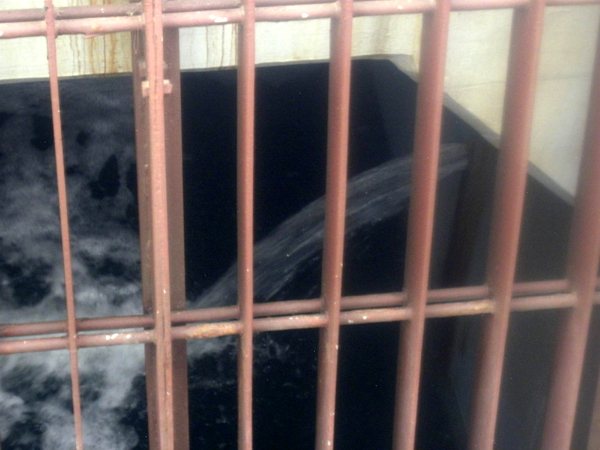Asia
Engineers fail to seal leak at Japan nuke plant
Updated: 2011-04-03 15:21
(Agencies)
 |
|
Radioactive contaminated water from the crippled Fukushima Daiichi Nuclear Power Plant No 2 reactor leaks through a crack in a concrete pit and drains into the ocean in Fukushima prefecture, northern Japan April 2, 2011 in this handout from Tokyo Electric Power. [Photo/Agencies] |
TOKYO – Engineers failed to seal a crack where highly radioactive water was spilling into the Pacific from a Japanese nuclear power plant incapacitated by last month's earthquake-spawned tsunami but said a search of the site found no other leaks Sunday.
The wave has carved a path of destruction up and down the coast and is believed to have killed 25,000 people. The first deaths at the Fukushima Dai-ichi nuclear plant itself, though, were confirmed Sunday by the operator. A 21-year-old and a 24-year-old were believed to be conducting regular checks at the complex when the 9.0-magnitude earthquake hit March 11.
It was unclear why the men did not evacuate when the quake hit.
The bodies were not discovered until Wednesday and had to be decontaminated. The announcement was delayed out of respect for the victims' families, TEPCO spokesman Naoki Tsunoda said.
Radiation has been spewing from the plant, leaking into the air, ground and sea. On Saturday, authorities discovered a crack from which radioactive water was spilling into the Pacific - the first time they identified a direct source of sea contamination.
A picture released by TEPCO shows water shooting some distance away from a wall and splashing into the sea, though the amount of water was not clear. The contaminated water will quickly dissipate in the ocean but could pose a danger to workers at the plant.
Pooling water at the nuclear complex - which is believed to ultimately come from the reactor cores - has repeatedly forced technicians to pull back and suspend their work.
After the massive tsunami knocked out power to the plant three weeks ago, cooling systems failed, and the reactors have been dangerously overheating since. A series of almost daily problems has led to substantial amounts of radiation leaking into the atmosphere, ground and sea in the world's worst nuclear crisis since the 1986 meltdown at Chernobyl in the former Soviet Union.
The 8-inch- (20-centimeter-) long crack in a maintenance pit at the Fukushima plant is believed to have been caused by the 9.0-magnitude earthquake that generated the wave. Water containing levels of radioactive iodine far above the legal limit spilled from it into the Pacific, said Hidehiko Nishiyama of Japan's Nuclear and Industrial Safety Agency.
Workers flooded the pit with concrete in an effort to seal the crack but couldn't get it to dry.
Next, they plan to inject polymer into a pipe that connects the pit to the rest of the system. Polymer can absorb enormous amounts of water and expands 50 times its original size.
Over the past 10 days, pools of contaminated water have been found throughout the plant and high levels of radioactivity have been measured in the ocean.
A search of the plant found no other similar leaks leading directly to the ocean. "We believe that's the only crack," said Tsunoda.
People living within 12 miles (20 kilometers) of the plant have been evacuated, but, as with previous leaks, it could pose a danger to workers.
A nuclear plant worker who fell into the ocean Friday while trying to board a barge carrying water to help cool the plant did not show any immediate signs of being exposed to unsafe levels of radiation, nuclear safety officials said Saturday, but they were waiting for test results to be sure.
Workers have been reluctant to talk to the media about what they are experiencing, but one who spent several days at the plant described difficult conditions in an anonymous interview published Saturday in the national Mainichi newspaper.
When he was called in mid-March to help restore power at the plant, he said he did not tell his family because he didn't want them to worry. But he did tell a friend to notify his parents if he did not return in two weeks.
"I feel very strongly that there is nobody but us to do this job, and we cannot go home until we finish the work," he said.
Early on, the company ran out of full radiation suits, forcing workers to create improvised versions of items such as nylon booties they were supposed to pull over their shoes.
Radiation worries have compounded the misery for people trying to recover from the tsunami. So far, 12,000 deaths have been confirmed, and another 15,400 people are missing.
Sunday marks the last day of an all-out joint search by the US and Japanese militaries for bodies in coastal waters. The effort is probably the final hope for retrieving the dead.
Specials

Fill dad's shoes
Daughter and son are beginning to take over the family business of making shoes.

Have you any wool?
The new stars of Chinese animation are edging out old childhood icons like Mickey Mouse and Hello Kitty.

Virtual memorial
High-Tech touches to traditional tombsweeping festival help environment



